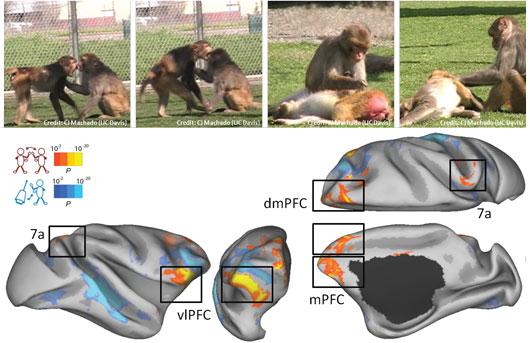We spend most of our time watching others, on the street, at work or even on television. When we do so, we process the shape of their faces and bodies, which are very salient features, but we also observe their motor actions and their interactions with other people. Interactions are especially informative because they reveal otherwise hidden properties about people, such as their thoughts and feelings, dominance or relationship status. We are not the only ones versed in people-watching; most primates live in large social groups and have the same pastime. For instance, monkeys recognize grooming, play, and fight, infer social rank from observing interactions, and utilize this knowledge to recruit allies. Despite the importance of understanding social interactions for monkeys’ social life, the brain circuitry devoted to this task remains a riddle.
To tackle this question, we used functional magnetic resonance imaging while monkeys watched videos of monkey encounters. In order to disentangle the different cognitive processes at play when watching a social scene and to capture the specificity of social interactions, we also showed videos of monkeys acting upon objects, of monkeys not acting, and of physical interactions between objects, along with several videos controlling for low-level features in the videos, including motion, color, contrast and luminance. We next compared monkeys’ whole-brain activity while watching videos of monkey interactions to the activity during other videos using generalized linear model group analysis and conjunction analyses.

Figure: Examples of social interactions between monkeys (Credit: CJ Machado, UC Davis). Brain areas exclusively activated when watching social interactions are represented in red to yellow, and brain areas preferentially activated when watching actions directed towards objects are represented in dark to light blue.
We found that watching social interactions engages three brain networks in the primate in different ways, including two well-studied brain networks and a novel one that appeared exclusively dedicated to social interaction processing. First, we found that watching social interactions engages those areas of the brain that respond selectively to specific visual shapes – namely, faces and bodies. Surprisingly, the body-selective areas of the macaques’ brains were more active when the animals watched videos of monkeys interacting with objects. Furthermore their face-selective areas activated even more in response to videos of monkey-on-monkey social interactions. This showed that face- and body-selective areas are not simply visual shape analyzers, but that they can also be modulated by the context in which those visual shapes are presented.
Social interactions also engaged the mirror neuron system, located in the parietal and premotor cortex. These brain areas contain specialized brain cells called mirror neurons, which fire when an animal performs an action such as grasping a stick or hitting a ball, or sees another animal performing the same action. This network was expectedly also active when monkeys watched other macaques playing with toys. Unexpectedly, we additionally found it active when monkeys watched objects colliding with other objects. This suggested that the mirror neuron system could be more involved than previously thought in understanding a variety of both social and non-social interactions.
Finally, social interactions activated yet another set of areas located outside of the face and body areas and mirror neuron system. We identified a portion of the network that responded exclusively to social interactions, remaining nearly silent in their absence. This socially sensitive network is located in areas of the brain that are close homologues of the brain areas for theory of mind in humans. Theory of mind is our ability to understand another person’s thoughts — to intuit their desires, read their intentions and predict their behavior. Yet monkeys have been shown to have only a limited theory of mind and to fail most of the cognitive tasks designed to investigate it. However, by showing the existence of this network of monkey brain areas that is specifically activated for the processing of social interactions, we suggest that it might be an evolutionary precursor to the neural network that produces theory of mind in our own brains. In turn, our unique and sophisticated mind-reading ability might have evolved from our shared ability with our monkey kin to read social interactions.
Reference
A dedicated network for social interaction processing in the primate brain. J. Sliwa, W. A. Freiwald, Science 356, 745 (2017). Doi: 10.1126/science.aam6383


































